1993 CHEVROLET S10 parking brake
[x] Cancel search: parking brakePage 53 of 356
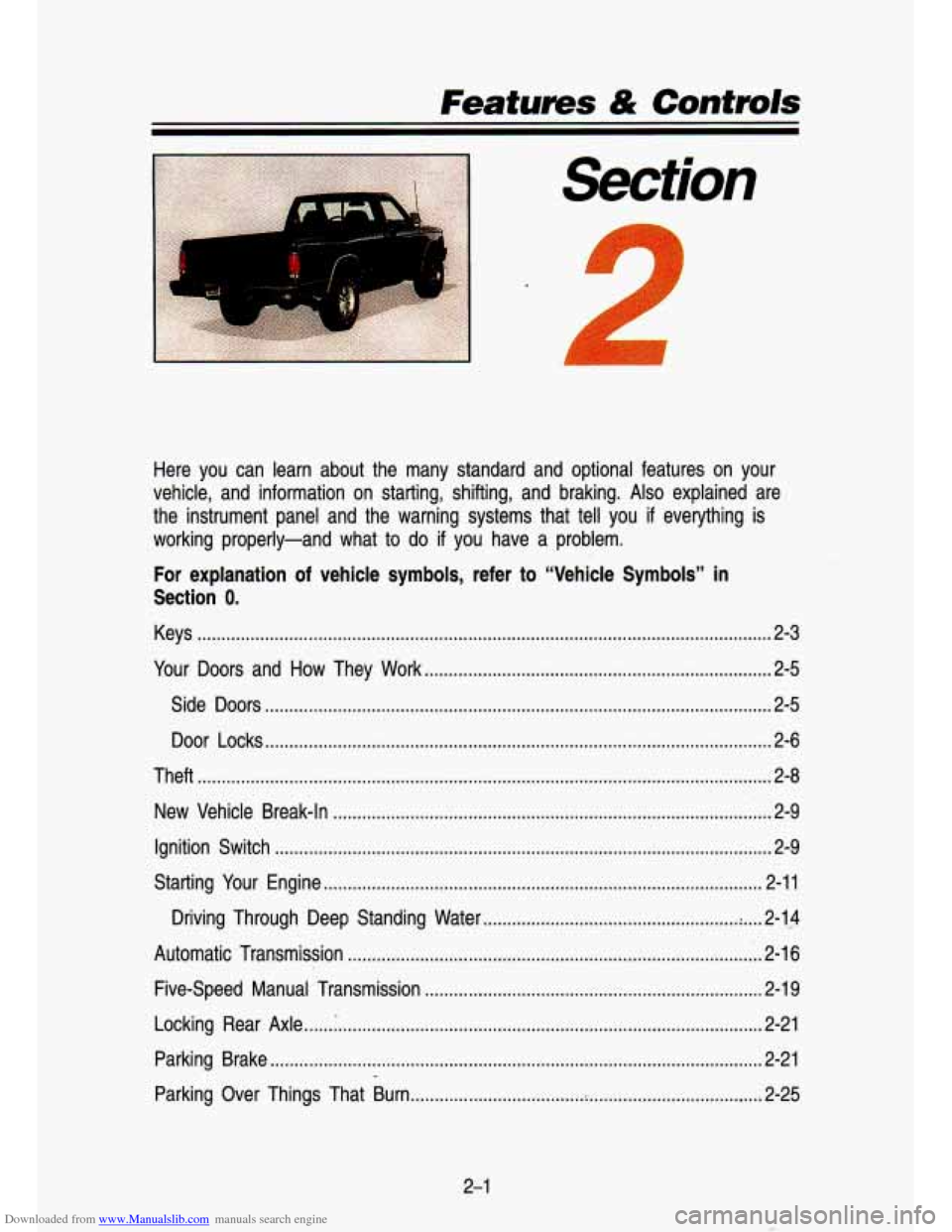
Downloaded from www.Manualslib.com manuals search engine Features & Controls
Here you can learn about the many standard and optional featur\
es on your
vehicle, and information on starting, shifting, and braking. Als\
o explained are
the instrument panel and the warning systems that tell you
if everything is
working properly-and what to do if you have a problem.
For explanation of vehicle symbols, refer to “Vehicle Symbols” in
Section 0.
Keys ......................,.........................,...........~...........\
...............................,...........,. 2-3
Your Doors and How They Work
............................................~.......................... \
2-5
Side Doors
.............I............r............................ .................................... .... ......... 2-5
Door Locks
........................................................................\
.................................. .- . , 2-6
Theft
........................................................................\
............................................... 2-8
New Vehicle Break-In
........................................................................\
............,...... 2-9
Ignition Switch
........................................................................\
............................... 2-9
Starting Your Engine
........................................................................\
................... 2-11
Driving Through Deep Standing Water
..................................................... .... 2-14
Automatic Transmission
........................................................................\
.............. 2-1 6
Five-Speed Manual Transmission ...................................................................... 2-1 9
Locking Rear
Axle ...... 1 ........................................................................\
................ 2-21
Parking Brake
........................................................................\
.............................. 2-21
Parking Over Things That Burn
........................................................................\
. 2-25
-
2-1
Page 69 of 356
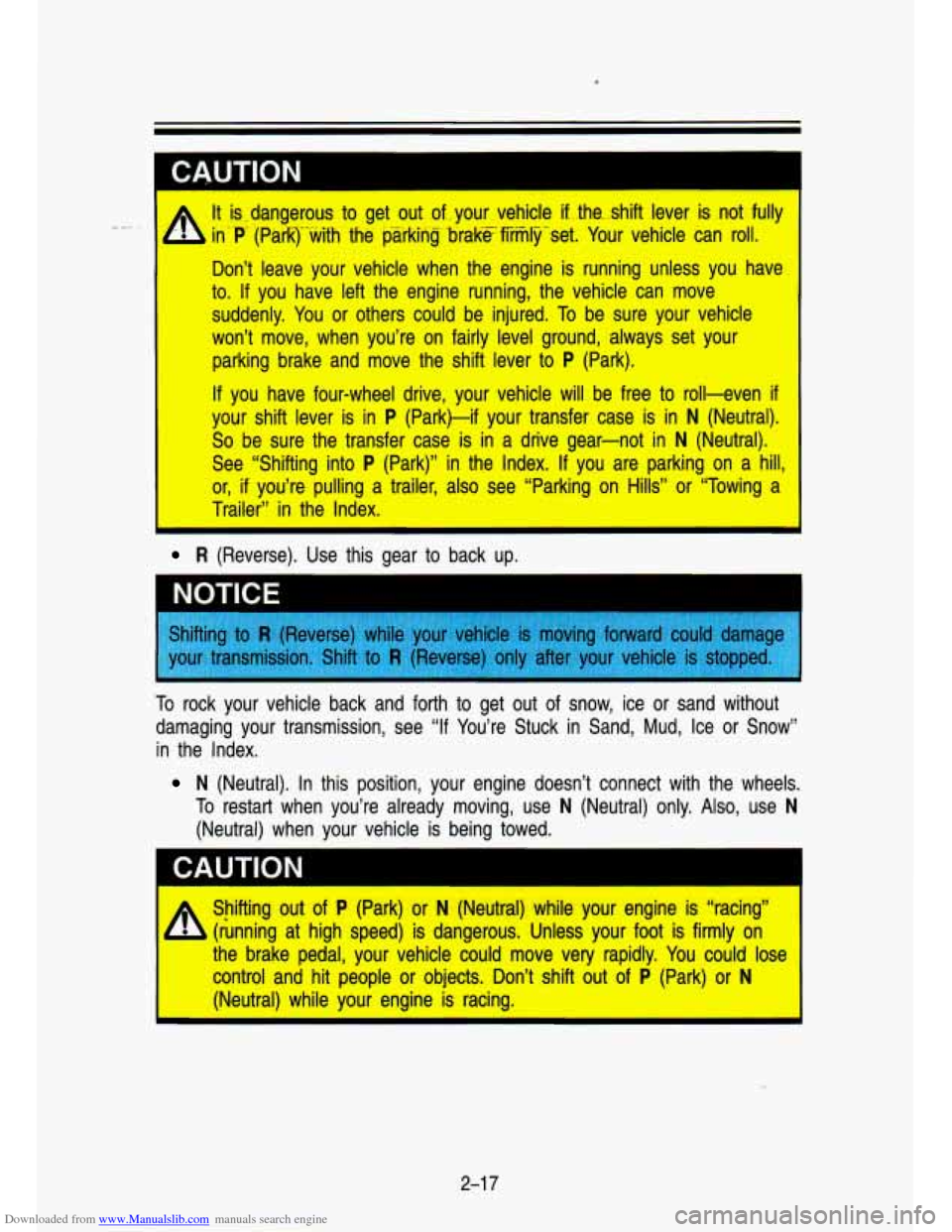
Downloaded from www.Manualslib.com manuals search engine I CAUTION
I A It is.-dangerous to get out of..your vehicle if. tha..shift lever is not fully
in-P (ParQ--wiih
the parking brake fiim~ljj-set. Yo’ur vehiclle ‘&n roll.
Doln’t leave your vehicle when the engine is running unless you have
to.
If you have left the engine running, tihe vehicle can move
suddenly. You or others could- be injured.
To be sure your vehicle
won’t move, when yolu’lre on fairly level ground, always set your
parking brake and move the shift lever to P (Park).
Of you have four-wheel drive, your vehicle will be free to roll-even if
your shift lever is in P (Park)i-if your transfer case i:s iln ‘N (Neutral).
So be sure the transfer case is in a drive gear-not in N (Neutral)’.
See “Shifting into P (Par’k)’’ in the Index. If you are ,parking on a hill,
or, if you’re p’ulling a traihr, also see “Parking on Hills” o:r “Towilnlg a
Trailer” in the Index.
R (Reverse). Use this gear to back up.
To rock your vehicle back and forth to get out of snow, ice or \
sand without
damaging your transmission, see
“If You’re Stuck in Sand, Mud, Ice or Snow”
in the Index.
N (Neutral). In this position, your engine doesn’t connect wi\
th the wheels.
To restart when you’re already moving, use N (Neutral) only. Also, use N
(Neutral) when your vehicle is being towed.
Shifting
out of P (Park) or N (Neutral) While your engine is “racing”
a (iunning aft hligh speed) is dangerous. ‘Unless your foot is firmly on
the brake ped’al,
your vehilcle could move very rapidly. You co1wl;d lose
(Neutral) while your engine is racing.
I contro’l and hit people or objects. Don’t shift out ‘of P (Park) or N
2-1 7
Page 73 of 356
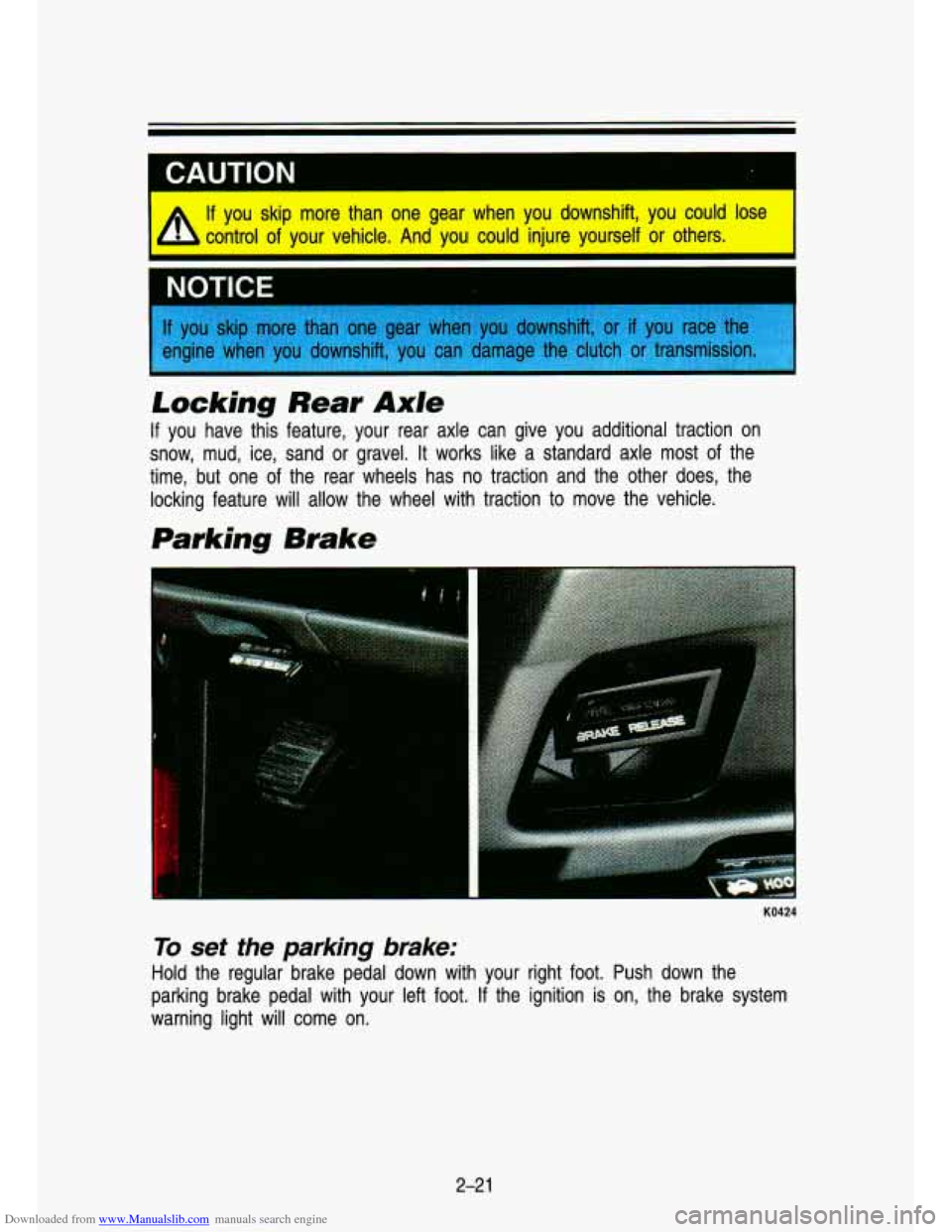
Downloaded from www.Manualslib.com manuals search engine CAUTION I
If you skip more than one gear when you downshift, you could lose
control of your vehicle. And you could injure yourself or others.
NOTICE
Locking Rear Axle
If you have this feature, your rear axle can give you additio\
nal traction on
snow, mud, ice, sand or gravel. It works like a standard axle\
most of the
time, but one of the rear wheels has no traction and the other does, the
locking feature will allow the wheel with traction to move the vehicle.
Parking Brake
KO424
To set the parking brake:
Hold the regular brake pedal down with your right foot. Push \
down the
parking brake pedal with your left foot.
If the ignition is on, the brake system
warning light will come on.
2-21
Page 74 of 356
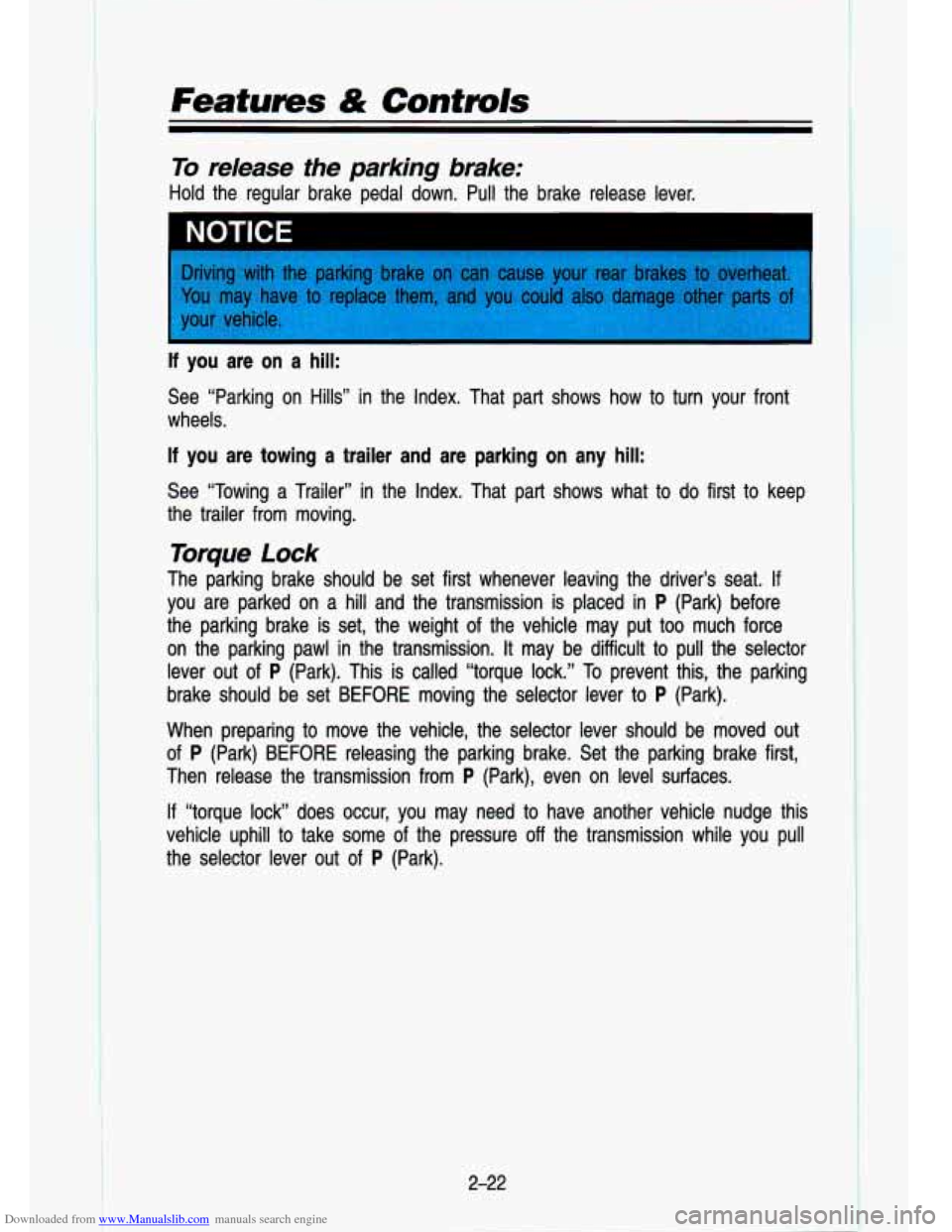
Downloaded from www.Manualslib.com manuals search engine Featums & Controls
To release the parking brake:
Hold the regular brake pedal down. Pull the brake release lever.
I NOTICE
If you are on a hill:
See “Parking on Hills” in the Index. That part shows how\
to turn your front
wheels.
If you are towing a trailer and are parking on any hill:
See “Towing a Trailer” in the Index. That part shows what to
do first to keep
the trailer from moving.
Torque Lock
The parking brake should be set first whenever leaving the driver’s seat. If
you are parked on a hill and the transmission is placed in P (Park) before
the parking brake is set, the weight of the vehicle may put too much force
on the parking pawl in the transmission.
It may be difficult to pull the selector
lever out of
P (Park). This is called “torque lock.” To prevent this, the parking
brake should be set BEFORE moving the selector lever
to P (Park).
When preparing to move the vehicle, the selector lever should \
be moved out of
P (Park) BEFORE releasing the parking brake. Set the parking br\
ake first,
Then release the transmission from
P (Park), even on level surfaces.
If “torque lock” does occur, you may need to have another vehicle nudge this
vehicle uphill to take some
of the pressure off the transmission while you pull
the selector lever out of
P (Park).
2-22
~
Page 75 of 356
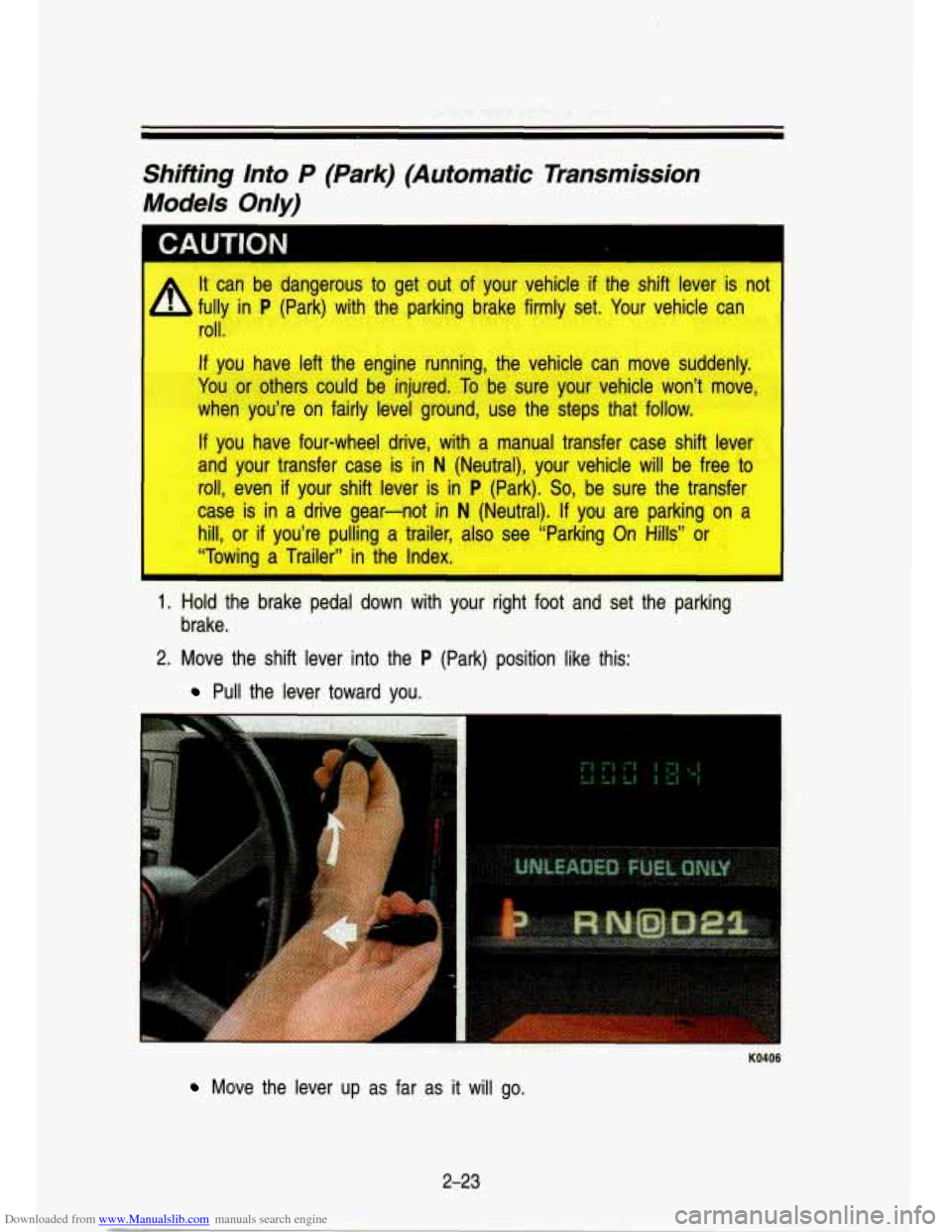
Downloaded from www.Manualslib.com manuals search engine Shifting Into P (Park) .(Automatic Transmission
Models Only)
fi A.UTION I.
It can be dangerous to get out of your vehicle if the shift lever is not I
fully in P (Park) with the parking brake firmly set. Your vehicle can
roll.
If you have left the engine running, the vehicle can move sudde..I,.
You or others could be injured.
To be sure your vehicle won’t move,
when you’re on fairly level ground, use the steps that foll\
ow.
If you have four-wheel drive, with a manual transfer case shif\
t lever
and your transfer case is in
N (Neutral), your vehicle will be free to
roll, even
if your shift lever is in P (Park). So, be sure the transfer
case is in a drive gear-not in
N (Neutral). If you are parking on a
hill, or
if you’re pulling a trailer, also see “Parking On Hills” or
“Towing a Trailer’’ in the Index.
1. Hold the brake pedal down with your right foot and set the parking
2. Move the shift lever into the P (Park) position like this:
brake.
Pull the lever toward you.
KO406
Move the lever up as far as it will go.
2-23
Page 76 of 356
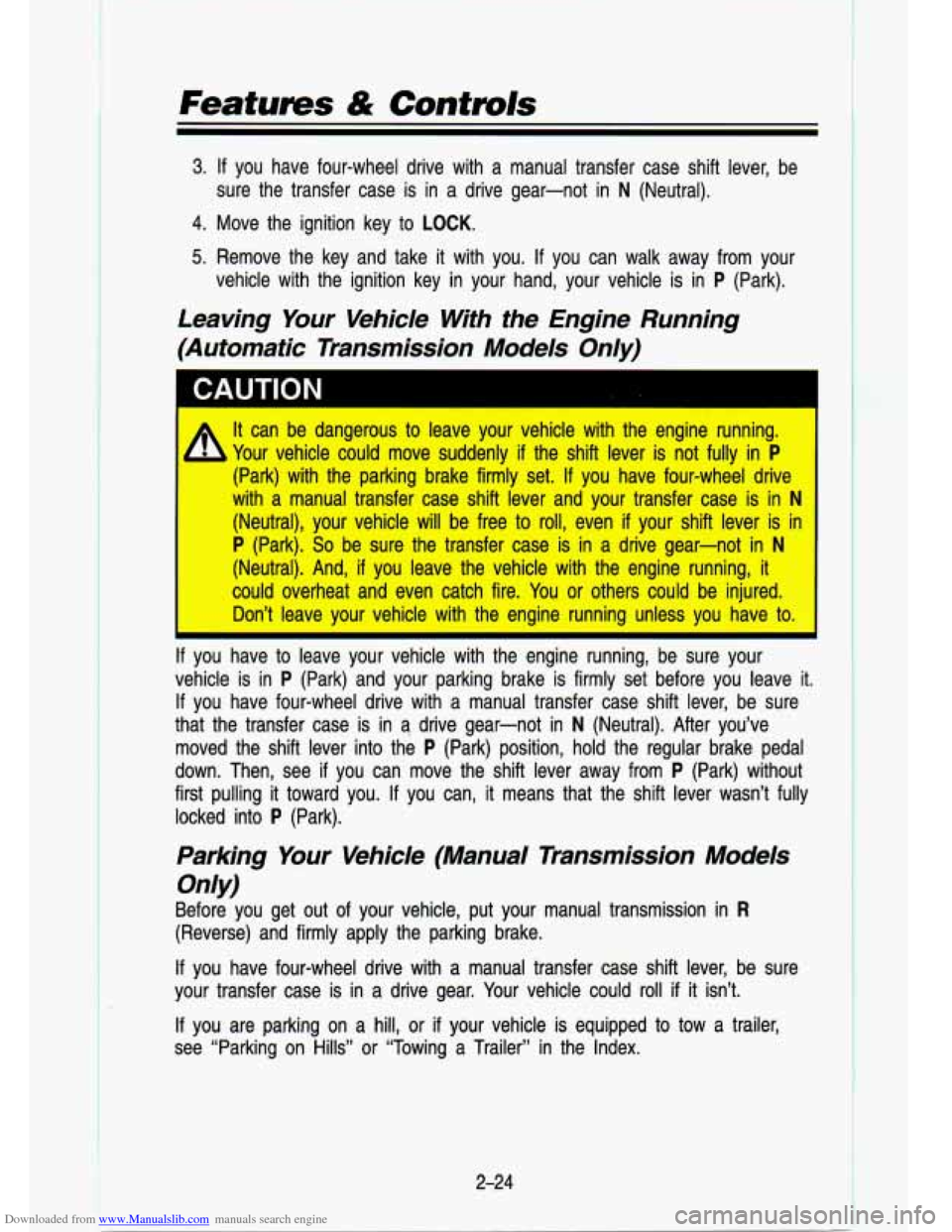
Downloaded from www.Manualslib.com manuals search engine Features & Contmls
3. If you have four-wheel drive with a manual transfer case shift\
lever, be
4. Move the ignition key to
LOCK.
sure the transfer case is in a drive gear-not in N (Neutral).
5. Remove the key and take it with you. If you can walk away from your
vehicle with the ignition key in your hand, your vehicle is in
P (Park).
Leaving Your Vehicle With the Engine Running
(Automatic Transmission Models Only)
1 CAUTION
It can be dangerous to leave your vehicle with the engine running.
Your vehicle could move suddenly
if the shift lever is not fully in P
(Park) with the parking brake firmly set. If you have four-wheel drive
with a manual transfer case shift lever and your transfer case\
is in
N
(Neutral), your vehicle will be free to roll, even if your shift lever is in
P (Park). So be sure the transfer case is in a drive gear-not in N
(Neutral). And, if you leave the vehicle with the engine running, it
could overheat and even catch fire. You or others could be injured.
I Don’t leave your vehicle with the engine running unless you have to.
If you have to leave your vehicle with the engine running, be sure your
vehicle is in
P (Park) and your parking brake is firmly set before you leave it.
If you have four-wheel drive with a manual transfer case shift le\
ver, be sure
that the transfer case is in
a drive gear-not in N (Neutral). After you’ve
moved the shift lever into the
P (Park) position, hold the regular brake pedal
down. Then, see if you can move the shift lever away from P (Park) without
first pulling it toward you.
If you can, it means that the shift lever wasn’t fully
locked into
P (Park).
Parking Your b bide (Manual Transmission Models
Before you get out of your vehicle, put your manual transmissi\
on in R
(Reverse) and firmly apply the parking brake.
If you have four-wheel drive with a manual transfer case shift le\
ver, be sure
your transfer case is in a drive gear. Your vehicle could roll
if it isn’t.
Only)
If you are parking on a hill, or if your vehicle is equipped to tow a trailer,
see “Parking
on Hills” or “Towing a Trailer” in the Index.
2-24
I
Page 79 of 356
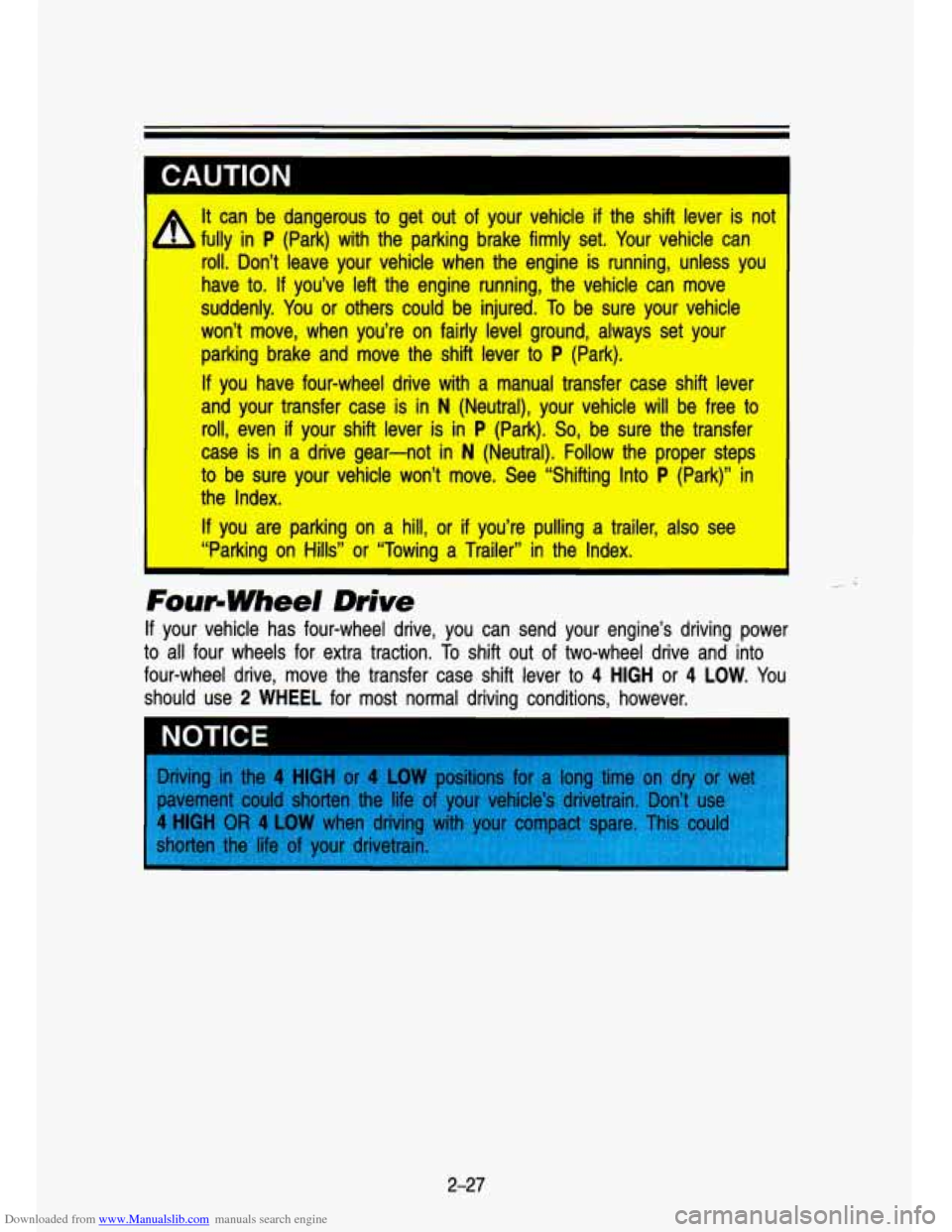
Downloaded from www.Manualslib.com manuals search engine It can be dangerous to get out of your vehicle if the shift llever is not I
fully in P (Park) with the parking brake firmly set. Your vehide can
roll. Don’t leave your vehicle when the engine is running, \
unlless y~
have to.
If you’ve left the engine running, tihe vehicle can move
suddenly.
You or others could be injured. To be sure your vehicle
won’t move, when you’re on fairly level ground, always se\
t your
parking brake and move the shift lever to
P (Park).
If you have four-wheel drive with a manual transfer case shift lever
and your transfer case
is in N (Neutral), your vehide will be free to
roll, even if your shift lever is in P (Park). So, be sure the transfer
case is in a drive gear-not
in ‘N (Neutral)., Follow the proper steps
to be sure your vehicle
won’t move. See “Shifting Into P (Park)” in
the Index.
If you are parking on a hill, or if you’re pulling a trailer, also see
“Farking on Mills” or “Towing a Trailer” in the Index.
If your vehicle has four-wheel drive, you can send your engine’\
s driving power
to all four wheels for extra traction.
To shift out of two-wheel drive and into
four-wheel drive, move the transfer case shift lever
to 4 HIGH or 4 LOW. You
should use
2 WHEEL for most normal driving conditions, however.
2-27
Page 80 of 356

Downloaded from www.Manualslib.com manuals search engine Features & Controls
Manual Transfer Case
I
PO1 63
The transfer case shift lever is on the floor to the right of the driver. Use this
lever
to shift into and out of four-wheel drive. An indicator light near the lever
shows you the transfer case settings:
2 WHEEL
4 HIGH
N SET PARKING BRAKE
4 LOW
The front axle portion
of the diagram on the indicator will light up when you
shift into four-wheel drive. A slight delay between shifting and the patte\
rn's
lighting is normal.
If the pattern does not light up, or if the front axle does
not go out after you shift out
of four-wheel drive, have your dealer check
your system. Turn the dial above your headlight switch
to the left to dim your
transfer case indicator light when your headlights or parking l\
ights are on.
2 WHEEL: This setting is for driving in most street and highway situations.
Your front axle is not engaged in two-wheel drive.
4 HIGH: This setting engages your front axle to help drive your vehicle.
Use
4 HIGH when you need extra traction, such as on snowy or icy roads, \
or in most off-road situations.
N SET PARKING BRAKE: Shift to this neutral setting only when your vehicle
needs
to be towed.
2-28
I